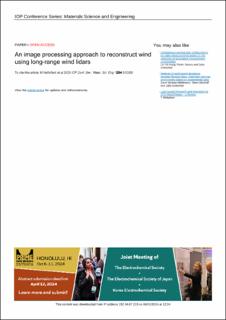| dc.contributor.author | Nafisifard, Mohammad | |
| dc.contributor.author | Jakobsen, Jasna Bogunovic | |
| dc.contributor.author | Snæbjörnsson, Jonas Thor | |
| dc.contributor.author | Agustsson, Halfdan | |
| dc.contributor.author | Grønsleth, M.S. | |
| dc.contributor.author | Undheim, O. | |
| dc.date.accessioned | 2024-04-17T12:02:00Z | |
| dc.date.available | 2024-04-17T12:02:00Z | |
| dc.date.created | 2024-01-02T09:31:38Z | |
| dc.date.issued | 2023 | |
| dc.identifier.citation | Nafisifard, M., Jakobsen, J. B., Snæbjörnsson, J. T., Ágústsson, H., Grønsleth, M. S., & Undheim, O. (2023, December). An image processing approach to reconstruct wind using long-range wind lidars. In IOP Conference Series: Materials Science and Engineering (Vol. 1294, No. 1, p. 012003). IOP Publishing. | en_US |
| dc.identifier.issn | 1757-8981 | |
| dc.identifier.uri | https://hdl.handle.net/11250/3127036 | |
| dc.description.abstract | Lidar-based wind sensing technology, originally used in the wind energy sector, is now being utilized in wind engineering to monitor wind action for designing fjord-crossing infrastructure like long-span bridges. Accurate estimation of design wind loads is crucial for the design process of such bridges. This paper examines wind data from two pairs of long-range lidars positioned along one side of the Sulafjorden, Norway, in a measurement campaign initiated by the Norwegian Public Roads Administration (NPRA). Two different scanning modes, the Plan Position Indicator (PPI) mode and the staring mode, with the fixed line-of-sight (LOS) orientation, are used to determine the line-of-sight wind speeds, the wind direction, and the related along wind speed. An image processing approach is used to compute along wind velocity information from all range gates based on the LOS wind speeds from two near-parallel lidar beams. The estimated along wind velocity is validated through wind data calculated at the intersection point of the two lidars, which provides velocity data with two horizontal components. The image-based reconstruction is found to produce reasonable wind speed estimates with a goodness-of-fit coefficient of R2 = 0.903. The mean wind direction estimate is smoothened but still comparable to the actual wind direction. The image processing approach shows promising potential to provide wind speed and direction information for all range gates for the lidar setup used, which can supplement traditional single-point wind velocity characterization by dual lidars. | en_US |
| dc.language.iso | eng | en_US |
| dc.publisher | IOP Publishing | en_US |
| dc.rights | Navngivelse 4.0 Internasjonal | * |
| dc.rights.uri | http://creativecommons.org/licenses/by/4.0/deed.no | * |
| dc.title | An image processing approach to reconstruct wind using long-range wind lidars | en_US |
| dc.type | Peer reviewed | en_US |
| dc.type | Journal article | en_US |
| dc.description.version | publishedVersion | en_US |
| dc.rights.holder | The authors | en_US |
| dc.subject.nsi | VDP::Teknologi: 500 | en_US |
| dc.source.journal | IOP Conference Series: Materials Science and Engineering | en_US |
| dc.identifier.doi | 10.1088/1757-899X/1294/1/012003 | |
| dc.identifier.cristin | 2218608 | |
| cristin.ispublished | true | |
| cristin.fulltext | original | |
| cristin.qualitycode | 1 | |

